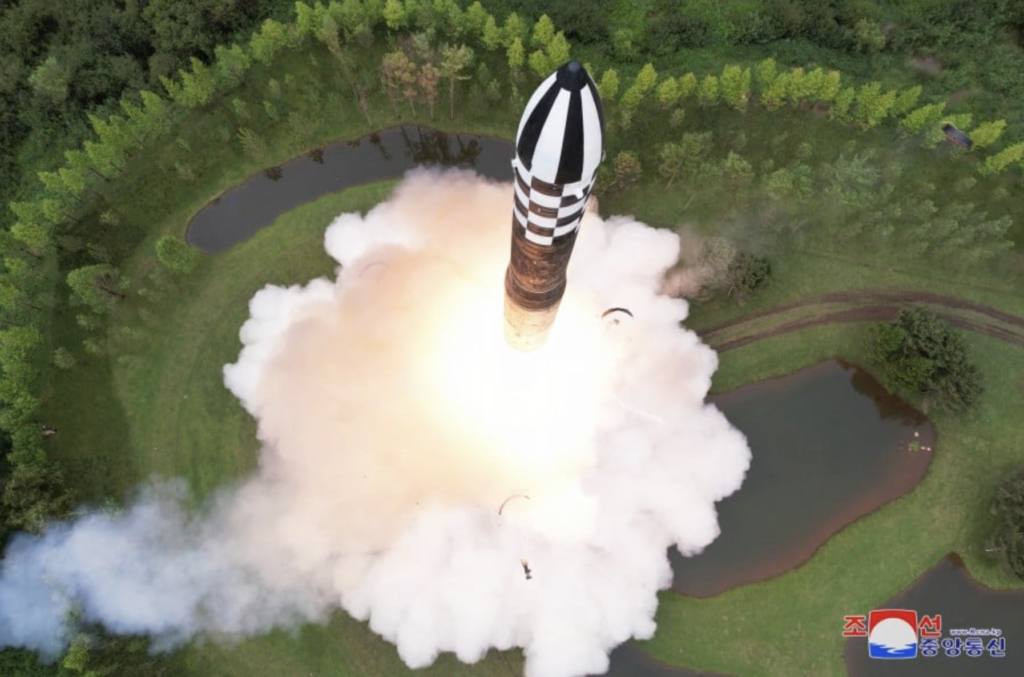North Korea’s Ballistic Missiles Program: A Comprehensive Guide

Introduction to North Korea’s Ballistic Missiles Program
Step into the world of North Korea’s ballistic missiles program, a subject that has captured the attention and concern of nations across the globe. In this comprehensive guide, we will delve deep into the history, development, capabilities, and international reactions surrounding this enigmatic program. Strap yourself in for an intriguing journey through time as we explore the fascinating arsenal of missiles possessed by North Korea. Get ready to uncover the impact these weapons have on global security and ponder what lies ahead for this controversial program. So grab your seatbelt and prepare for an eye-opening ride!
History and Timeline of Development
The history and timeline of North Korea’s ballistic missile program is a complex and ever-evolving narrative. It all began in the 1970s, when North Korea started acquiring Soviet-made Scud missiles. These short-range ballistic missiles laid the foundation for their subsequent development efforts.
In the late 1980s, North Korea began investing heavily in research and development to improve its missile capabilities. This led to the indigenous production of longer-range missiles like the Nodong-1, which could reach targets up to 1,000 kilometers away.
By the early 2000s, North Korea had made significant progress with its missile program. They successfully tested their Taepodong-1 missile in 1998, demonstrating an intermediate-range capability with a range of over 2,000 kilometers.
However, it was not until October 2006 that North Korea conducted its first nuclear test. This marked a major shift in their strategic posture and further escalated tensions within the international community.
Over time, North Korea continued to develop and test various types of ballistic missiles. They introduced new variants such as Musudan (Hwasong-10) medium-range ballistic missile and Hwasong-12 intermediate-range ballistic missile.
In recent years, Kim Jong-un has accelerated these developments significantly by testing intercontinental ballistic missiles (ICBMs). The successful tests of Hwasong-14 (2017) and Hwasong-15 (2017) showcased their ability to potentially reach mainland United States territory.
As we move forward into an uncertain future regarding North Korea’s intentions with its nuclear weapons program alongside advancements in delivery systems such as intercontinental ballistic missiles (ICBMs), it is crucial for global powers to remain vigilant while seeking diplomatic resolutions
Types of Missiles in North Korea’s Arsenal
North Korea’s ballistic missiles program is a cause for concern among the international community. The country has been actively developing and testing various types of missiles, adding to its growing arsenal. Let’s take a closer look at some of the missile systems that North Korea possesses.
One of the most well-known missiles in North Korea’s arsenal is the Hwasong-15. This intercontinental ballistic missile (ICBM) has a reported range of over 13,000 kilometers (8,100 miles), which puts major cities within reach, not only in neighboring countries but also as far away as parts of Europe and Alaska.
Another notable missile is the Hwasong-14, an ICBM that was test-fired multiple times between July 2017 and November 2017. It has an estimated range similar to the Hwasong-15 and poses a significant threat to regional stability.
In addition to these long-range missiles, North Korea possesses intermediate-range ballistic missiles (IRBMs) such as the Musudan and Taepodong-2. These IRBMs have ranges varying from approximately 3,000 to 6,000 kilometers (1,900 to 3,700 miles), allowing them to target countries within East Asia including Japan and South Korea.
Furthermore, North Korea also possesses short-range ballistic missiles (SRBMs) like Scud-B/C/D/E/F variants with ranges up to approximately 1,300 kilometers (800 miles). These SRBMs are often used for tactical purposes during military exercises or displays of force near its border with South Korea.
It is important to note that while some tests may fail or fall short of their intended targets during development phases; nonetheless it demonstrates North Korea’s commitment towards advancing its missile capabilities even further.
The variety and advancement seen in North Korean missile systems underline their determination to pose credible threats both regionally and potentially on a global scale. This has raised serious concerns among neighboring countries and the
Capabilities and Range of the Missiles

The capabilities and range of North Korea’s ballistic missiles program have been a cause for concern in the global community. With each successful test, the regime has displayed an increasing ability to develop long-range missiles capable of reaching targets far beyond its borders.
One of the most notable missiles in North Korea’s arsenal is the Hwasong-15, which was first tested in 2017. This intercontinental ballistic missile (ICBM) has an estimated range of over 13,000 kilometers (8,100 miles), putting major cities on the United States mainland within striking distance.
In addition to ICBMs, North Korea possesses a variety of other missile types with varying ranges. Medium-range ballistic missiles such as the Hwasong-12 can reach approximately 4,500 kilometers (2,800 miles), while shorter-range Scud-type missiles have a reach of around 1,000 kilometers (620 miles). These capabilities pose significant threats to neighboring countries like South Korea and Japan.
Moreover, it is important to note that North Korea continues to make advancements in its missile technology. The country has conducted numerous tests over the years and has shown progress in areas such as solid-fuel propulsion systems and re-entry vehicle technology. These developments suggest that their missile program will only become more sophisticated over time.
The international community has responded strongly to these advancements by imposing sanctions on North Korea aimed at limiting its access to resources necessary for further development. However, despite these measures, North Korea remains determined to continue advancing its missile capabilities.
In conclusion,
the capabilities and range of North Korea’s ballistic missiles program are alarming not just for its immediate neighbors but also for global security at large. The potential reach of their long-range missiles raises concerns about nuclear proliferation and destabilization in East Asia.
International Reactions and Sanctions
North Korea’s ballistic missiles program has garnered widespread attention from the international community, leading to a range of reactions and sanctions in an effort to curb its development. Various countries have expressed their concerns over North Korea’s missile tests, viewing them as a threat to regional and global security.
The United Nations Security Council (UNSC) has issued multiple resolutions imposing sanctions on North Korea due to its continued missile launches. These measures include restrictions on trade, arms sales, financial transactions, and travel bans for individuals involved in the program. The goal is not only to deter North Korea from further missile testing but also to prevent the proliferation of technology that could be used by other rogue states or non-state actors.
Many countries have supported these sanctions as a means of exerting pressure on Pyongyang. The United States has been particularly vocal in condemning North Korea’s actions and seeking strong multilateral measures against it. Additionally, Japan and South Korea are directly threatened by North Korean missiles, prompting them to support robust international responses.
However, there are differing views among nations regarding the effectiveness of sanctions alone in curbing North Korea’s missile program. Some argue that dialogue and engagement may be more productive than isolationist policies. China, for example, despite being critical of North Korea’s actions publicly, maintains some economic ties with the country.
While there is no consensus on how best to address this complex issue diplomatically or through punitive measures alone , it is clear that the international community remains united in its concern over North Korea’s ballistic missiles program . Continued efforts will be needed to find a solution that ensures stability in Northeast Asia while addressing geopolitical challenges posed by Pyongyang’s weapons capabilities.
Current State and Future Outlook of the Program

The current state of North Korea’s ballistic missiles program is a topic of great concern for international security experts. Despite numerous sanctions and diplomatic efforts to curb their progress, North Korea has continued to make advancements in its missile technology.
In recent years, North Korea has conducted several high-profile missile tests, showcasing their growing capabilities. These tests have included both short-range missiles that threaten neighboring countries like South Korea and Japan, as well as intercontinental ballistic missiles (ICBMs) with the potential to reach targets as far away as the United States.
This steady progression in missile development has raised alarm bells around the globe. The international community closely monitors each test launch, analyzing data to determine how close North Korea may be to achieving its ultimate goal – a fully functional nuclear-armed ICBM.
Looking towards the future, it is uncertain how the situation will unfold. Some experts believe that increased economic pressure and diplomatic negotiations could eventually lead to denuclearization on the Korean Peninsula. However, others remain skeptical about North Korea’s willingness to give up its nuclear weapons program entirely.
Additionally, there are concerns over potential proliferation threats posed by North Korea selling or sharing its missile technology with other rogue states or non-state actors. This raises serious questions about global security and calls for increased vigilance from intelligence agencies worldwide.
As tensions continue between North Korea and various nations such as the United States and South Korea, it is clear that this issue will remain at the forefront of discussions on international security. Finding a peaceful resolution while ensuring stability in East Asia remains an ongoing challenge for world leaders.
In conclusion (!), understanding the current state of North Korea’s ballistic missiles program is crucial for assessing global security risks. While progress has been made in terms of applying pressure through sanctions and diplomacy, there are still significant challenges ahead when it comes to curbing further advancements in missile technology by Pyongyang
The Impact of North Korea’s Ballistic Missiles on Global Security
North Korea’s ballistic missiles program has caused significant concerns in the international community, particularly when it comes to global security. The development and testing of these missiles have raised tensions and increased the risk of conflict in the region.
One major impact is the threat that North Korean missiles pose to neighboring countries, such as South Korea and Japan. With their advanced capabilities and range, these missiles can potentially reach targets within these nations, putting millions of lives at risk. This has forced these countries to invest heavily in defense systems and increase cooperation with other allies for collective security.
Furthermore, North Korea’s missile program has also led to an escalation in military spending across Asia-Pacific nations. As a result, there is a growing arms race in the region as countries strive to enhance their own defense capabilities against potential missile attacks. This increase in military expenditures diverts resources that could have been used for social welfare or economic development.
Another concerning aspect is the potential for nuclear proliferation. If North Korea successfully miniaturizes its nuclear warheads to fit onto its ballistic missiles, it would not only threaten regional stability but also raise global fears about the spread of nuclear weapons technology.
Moreover, the unpredictable nature of Kim Jong-un’s regime adds another layer of complexity to this issue. The possibility that North Korean missiles could be launched without warning increases uncertainty and heightens tension between nations within striking distance.
Additionally, there are broader implications for global security regarding non-proliferation efforts and diplomatic relations with other rogue states seeking similar capabilities. The success or failure of dealing with North Korea’s program will set a precedent for how other countries pursue their own illicit missile programs.
In conclusion,
North Korea’s ballistic missiles program poses significant challenges to global security on multiple fronts – from threatening regional stability and increasing militarization efforts among neighboring nations to raising fears about nuclear proliferation worldwide. It demands careful diplomacy combined with strong deterrence measures to address these concerns effectively. The international community must continue working together to find
Conclusion
North Korea’s ballistic missiles program has been a cause of concern for the international community for many years. The country’s relentless pursuit of developing and enhancing its missile capabilities has raised serious questions about global security.
The history and timeline of development demonstrate North Korea’s determination to achieve self-reliance in missile technology. Despite facing numerous challenges and setbacks, the regime has made significant progress over the years, leading to the production of different types of missiles.
With an arsenal that includes short-range Scud missiles, medium-range Nodong missiles, intermediate-range Musudan missiles, and intercontinental ballistic missiles (ICBMs) like Hwasong-14 and Hwasong-15, North Korea possesses a formidable military capability. These weapons have varying ranges that can potentially reach targets not only in neighboring countries but also as far as the United States mainland.
The international reactions to North Korea’s ballistic missile tests have been swift and decisive. In response to these provocations, various sanctions have been imposed on Pyongyang by the United Nations Security Council as well as individual nations. These measures aim to curb North Korea’s ability to further enhance its missile program while sending a strong message against such reckless behavior.
Looking ahead, it is uncertain how North Korea’s ballistic missile program will evolve in the future. Efforts towards denuclearization through diplomatic negotiations continue with mixed results. However, until concrete steps are taken towards disarmament and peace-building on the Korean Peninsula, concerns over Pyongyang’s missile capabilities will persist.
North Korea’s ballistic missiles pose a significant threat not only regionally but also globally due to their potential range and destructive power. This underscores the importance of maintaining strong alliances among affected nations while fostering dialogue with Pyongyang toward peaceful resolutions.
Understanding North Korea’s ballistic missile program is crucial for comprehending its impact on global security dynamics. By remaining vigilant and united in our approach towards addressing this issue diplomatically yet firmly, the international community can strive for a safer and more stable world.



